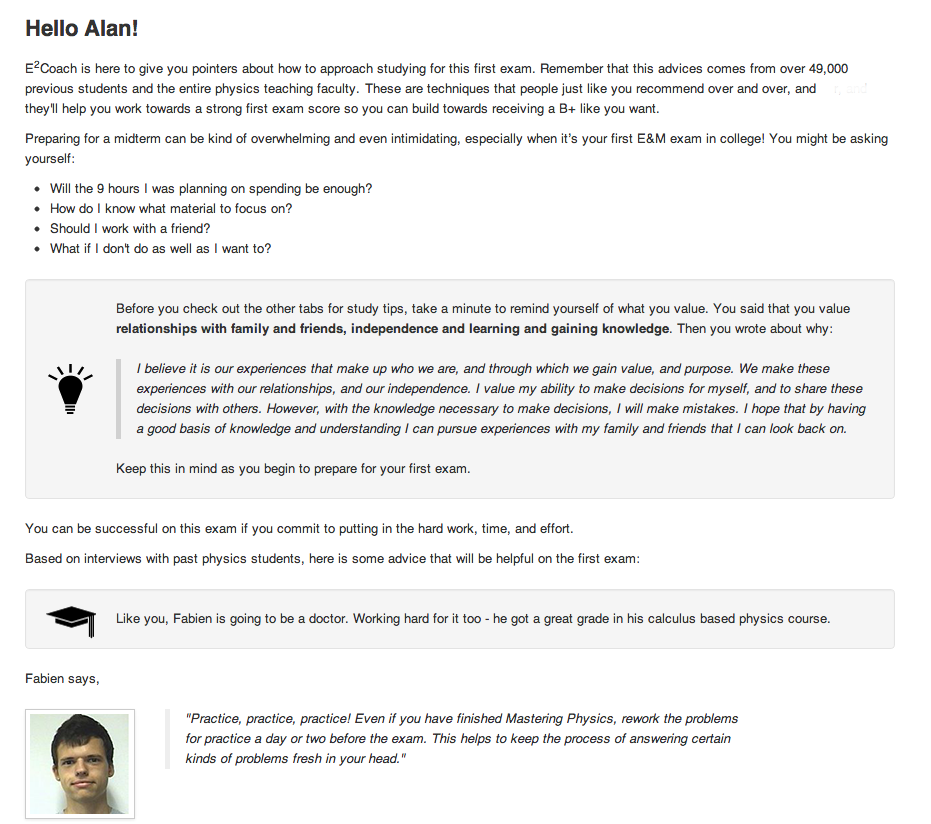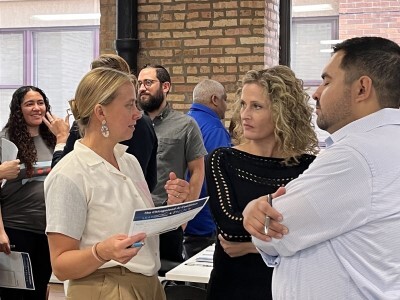Technology Tools
E2Coach: Customized Support for Learning Success
Topics

Educators often take advantage of educational technologies as they make the shifts in instruction, teacher roles, and learning experiences that next gen learning requires. Technology should not lead the design of learning, but when educators use it to personalize and enrich learning, it has the potential to accelerate mastery of critical content and skills by all students.
E2Coach, a project at the University of Michigan funded by NGLC, shows students their progress in a class and gives them individual ideas to improve their outcomes.
Our world is becoming increasingly personalized. Online shopping, search, social media, and movie services make tailored suggestions based on your behavioral data and the data of others. For instance, Netflix personalizes recommendations to its 36.3 million subscribers by a complex algorithm that uses billions of item ratings, social data, queue lists, and how long each item is watched. The result: rows of movie suggestions tailored to the subscriber’s tastes. What if such personalization could be applied to education?
We’re working on it. E2Coach, a project of the University of Michigan, provides a way to communicate personally with every student in the classroom. This project was among those which addressed NGLC’s “Building Blocks for College Completion” learning analytics challenge. Born from the realization that tailored feedback and advice need not be limited to office hours, E2Coach delivers customized messages to students that address how they are performing, and how they can do better. The aspects of student performance it discusses are varied, as are the counseling strategies–an account of the many factors that influence E2Coach and their outcomes is available in a recent blog post by the project director, Tim McKay.
What is particularly striking about E2Coach is the truly personal experience that it provides the student. Every word in every message is intently written by someone familiar with the student experience as well as the discipline, and through the flexibility and power of the Michigan Tailoring System, a message author ensures that each student receives exactly the words she wants him to have. How can the author know each student so well? Through a survey offered at the beginning of the term, students provide us with information such as their major, their prior experience with the material, and what they anticipate their study habits will be. It is primarily through this account of goals, preparation, and attitudes that the messages can go beyond commenting only on grades and address a more nuanced story: the student’s.

To a student new to physics who surpasses his expectations for his first exam, E2Coach offers its wholehearted congratulations. To a student who agrees with the statement, “Basic math skills (solving equations, trigonometry, basic calculus) will pose a challenge to me in this course,” the program recommends online and on-campus math resources . And to a student with low confidence, E2Coach offers extra encouragement. While much of this advice comes from others, it is delivered through a message author’s personal voice. This past summer, that voice was mine.
I took on the role of message author shortly after I graduated from the University of Michigan with a degree in physics: I had taken the very classes I was writing messages for only a few years previously. I experienced a variety of successes and failures in those classes, and as I wrote a potential message to a student, I couldn’t help but relate to what he or she might be going through. I channeled this empathy into a tone of camaraderie and trustworthiness in the message. My intention was to have the message come across as a sincere “I want you to succeed.”
Like other websites, E2Coach conveys its messages in ways that extend beyond the words themselves. My E2Coach team members and I were all keenly aware that some of the feel of E2Coach is derived from the page surrounding the text. We faced the same decisions as any web designer does regarding page layout, color scheme, and typeface, and a priority of mine was ensuring that E2Coach kept up with ever-advancing online aesthetics. While the site’s design has undergone several iterations, its current form suits the student well. Structurally, E2Coach messages arrive in an inbox on a student’s personal account on the E2Coach website. The inbox metaphor reinforces students’ understanding that they are receiving private, personal advice, and sending all of their E2Coach messages to the same inbox ensures convenience for the student. Another convenient feature is E2Coach’s responsive front-end design, which allows students to access their messages easily on any device. Informed by best practices and the necessity that E2Coach feel like a safe, welcoming resource, we use unassuming font types, and warm, friendly colors. Since E2Coach is currently accessible to University of Michigan students, those chosen colors are our school’s colors–maize and blue.
In sum, E2Coach is an individualized tool that feels very personal. By providing tailored advice in this manner, we hoped to improve students’ performance. Analysis of first-year data shows that the students who used E2Coach frequently did better than expected, supporting the program’s cause and the potential for computer tailored communication in education.




